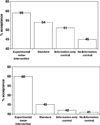Beyond the most willing audiences: a meta-intervention to increase exposure to HIV-prevention programs by vulnerable populations
- PMID: 18823190
- PMCID: PMC4783148
- DOI: 10.1037/0278-6133.27.5.638
Beyond the most willing audiences: a meta-intervention to increase exposure to HIV-prevention programs by vulnerable populations
Abstract
Objective: Enrollment in HIV-prevention interventions is more likely when the audience has safer rather than riskier HIV-relevant behavior. Thus, a meta-intervention was designed to increase participation by an audience of infrequent condom users in Florida.
Design: Participants (N = 400) were randomly assigned to 1 of 4 conditions varying the introduction to a counseling program. In the experimental condition, participants were told that the intervention gave participants options but might not change their behavior. In a standard-introduction condition, participants were told that the program was highly effective at changing participants' behaviors. There was also an information-control group containing a description of the program, and a no-information-control group solely containing an invitation.
Main outcome measures: The outcome measure was actual participation in the offered counseling.
Results: Findings indicated that the experimental introduction was the most successful at yielding participation in the counseling program when the audience had low intentions to use condoms in the future.
Conclusion: Intervention introductions countering participants' resistance to change increase participation in HIV-prevention counseling among reluctant clients. Other meta-interventions may be explored to systematically augment the effectiveness of evidence-based health-promotion interventions.
PsycINFO Database Record (c) 2008 APA, all rights reserved.
Figures
References
-
- Amaro H. Love, sex, and power: Considering women’s realities in HIV prevention. American Psychologist. 1995;50:437–447. - PubMed
-
- Amaro H. On the margin: Power and women’s HIV risk reduction strategies. Sex Roles. 2000;42:723–749.


